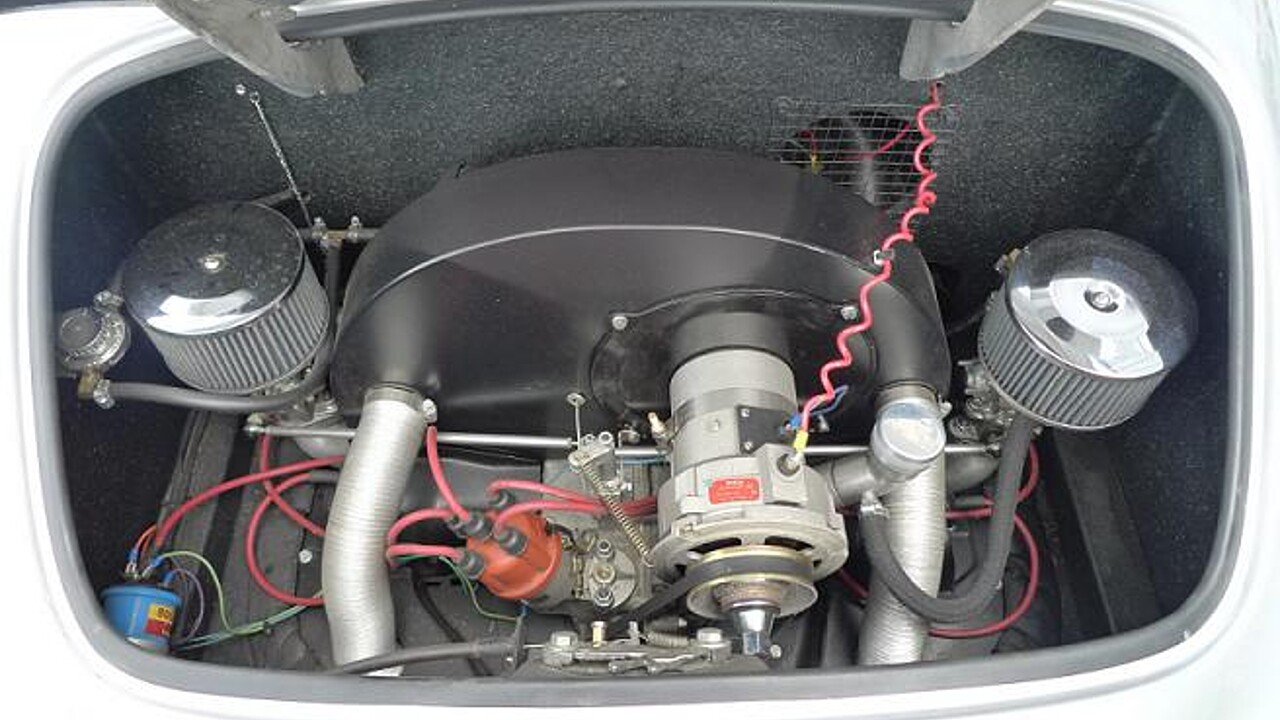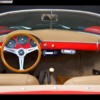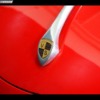Happy holidays guys. Anyone know how to determine build date of a vintage speedster? Is there a hidden data plate somewhere? Early car based on floor e-brake? On a 68’ pan with Mexican motor with hydraulic valves if that helps. (forum members helped me figure that out![]()
Replies sorted oldest to newest
How to date my Vintage Speedster: Arrive on time neat and trim, smile and be polite, open doors etc...You'll do just fine .
At this point probably not. To the best of my recollection Kirk did not keep those records and he has since retired and sold the business. That business was then moved to Arizona, went out of business, and was sold to someone else.
You MIGHT be able to have a VIN history done by the DMV to determine which years it was registered. The large gap between two particular years might tell you when it was built. Not sure if DMV still offers that service or not but you could probably search online to see if they do.
.
If you post some photos of your engine compartment and interior (seats, door cards, instruments, steering wheel, etc.) we may be able to give you an idea of general time frame. The more trim details the better.
For example, is the heavy wire on the distributor a coiled, red wire? Is the steering wheel a real Nardi or a replica? Does the speedo read in miles or kilometers?Sometimes, the model of carburetor and linkage will tell a story.
We love speculating about things we don't know for certain.
.
Any chance you know who PO was? Did you buy it from PO or from a dealer? Post photo's it might be recognized here.
.
Based on just that wire, real Nardi wheel, and door cards, I'd guess earlier than 2013.
The lack of a vent opening in the firewall into the compartment just ahead, makes me want to say at least five years earlier than that, but not sure.
Any other opinions?
.
Mitch, Thank You for weighing in. Keith
The CA registration should have year first sold. That would probably be the re-registration of the VW pan. My guess based on the pictures and hydraulic lifters is that it was made around 2005.
-=theron
You also have a potentially very serious fire issue I just noticed on the engine picture. The red positive wire is touching the fan shroud. Through vibration, the red wire will wear and make contact with the grounded fan shroud. That will start a nasty fire. If you check the back of that red wire I bet it has wear already. Vintage Speedsters started putting a plastic spacer and tie wrap to keep this from happening somewhere around 2004. Here is a picture of the spacer and wrap. Whatever you do, get this fixed before your have a fire.
-=theron
Great eye for detail and dating method. Can/will fix. Understand the potential. Thank you.
Doesn't your car have an Assigned Identification Number sticker? Mines from CA, but I've seen pictures of a similar one (from FL or AZ, IIRC.)
Seems like you could find out from the DMV when it was first titled.
Theron et al: Wasn't Kirk installing Mexicrate engines back into the 1990's? I visited his shop sometime around 1997 or so and he had several engines sitting on palletts and told me they were from Mexico. Just thinking out loud here.....
@dlearl476 posted:Doesn't your car have an Assigned Identification Number sticker? Mines from CA, but I've seen pictures of a similar one (from FL or AZ, IIRC.)
Seems like you could find out from the DMV when it was first titled.
I think most were registered with the VW pans chassis number (pseudo-VIN).
MOFOCO was a big builder of T1 engines with hydraulic lifters too.
In my experience with many Vintage built Speedsters, I've noticed that most of them with 1600cc motors did not have the vent hole in the firewall. Almost all of the ones with 1915cc motors did have the hole. I haven't noticed any correlation between having or not having the vent to the year of the build.
How did you determine that it had hydraulic lifters?
Troy, thank you for replying. If I can get CA DMV on phone and give them some $, maybe they can provide title or registration info that might show when VW VIN became a REPLICA vin..... regarding hydraulic lifters.. when attempting to set lash (and more importantly with friend’s help with A&P cert) we noticed that when pushing bottom of rocker to eliminate free play, we could get pushrod to move slightly in-out as if spring loaded or “squishy” ...this was the giveaway. I would not have figured it out alone. He’s seventy and adjusted lots of valves on all manner of VW’s and aircraft motors.
Calif DMV isn't going to be any help at all if you are thinking they have records of it changing from a VW to a Special Construction title. Don't waste your time. How and where is it currently registered?
I'm not so sure your method of determining hydraulic lifters is accurate, but I really don't know. Maybe get a second opinion.
Car was titled in MT when I bought it. Now titled in ID against VW pan VIN. NBS auto showroom in Milpitas, CA either represented first owner or bought car from first owner. Reaching out to them. Not a big deal either way. Have a great day. Keith
If it's still registered as a VW, then the DMV won't have any other information other than what Robert suggested, which might be a large gap between the registration renewals.
Troy wrote: "I'm not so sure your method of determining hydraulic lifters is accurate, but I really don't know. Maybe get a second opinion."
Second Opinion:
Yup. That's how you do it. If the lifters are stock, solid lifters and you run the valve adjuster in to zero clearance, it won't go anymore, period, because you've bottomed out the push rod and (solid) lifter.
If it has hydraulic lifters and you turn the adjuster to zero clearance at the valve stem, you can then keep turning a number of turns as the push rod makes the lifter piston collapse, then back it out 1/2 - 3/4 of the collapsed length (you have to count turns, here) and you're done. There is a spring inside the lifter to provide the proper "rest" pressure. The VW techs would set them at any engine temp by relieving pressure from the valve stem adjuster, then turn it back in 1 or 2 turns, no more, and they were done. Once they're adjusted you really never have to check them again, but this group probably would! It's important to know that hydraulic lifters give you zero clearance between the rocker arm adjuster and the valve stem at all times, hot or cold, but they automatically adjust for oil/engine temp changes, keep a pre-determined pressure against the valve stem when "closed" and a stronger pre-determined pressure against the stem when pushing it "open". They're usually quieter running because of this.
I'm also seventy and adjusted lots of valves on all manner of VW’s (but sadly, no aircraft motors).
Thanks Gordon. That makes more sense. It sounded to me like he was just able to feel a "squishy" feeling by pressing with his fingers.
@Bubbasev posted:Car was titled in MT when I bought it. Now titled in ID against VW pan VIN. NBS auto showroom in Milpitas, CA either represented first owner or bought car from first owner. Reaching out to them. Not a big deal either way. Have a great day. Keith
@Troy Sloan posted:If it's still registered as a VW, then the DMV won't have any other information other than what Robert suggested, which might be a large gap between the registration renewals.
I didn’t realize the car had been registered out of state. That will reduce the chances of DMV having accurate info. Depending on when it left the state of CA the old records may have been purged already. I wouldn’t tell DMV it’s a replica though. Just tell them it’s a VW.
CA DMV actually returned my call. Had only been registered as 68 VW in CA. That’s what I would have done also.
I looked at that very car at NBS in mid-October of 2017.
I ended up buying a nearly identical red / tan 2003 VS from a private seller and here in California it is registered as a 1969 VW.
From all I’ve read on this site and heard from others registering theses as a SPCN can be troublesome, registering as a VW based on the VIN is exceedingly easier.
A small world gets smaller!
I think the first hydraulic lifters were manufactured and sold by Ed Iskenderian in 1966. I bought a set and installed them in my Type 3 Fastback in 68. Had no trouble with them................Bruce
Yeah, they're actually pretty slick. I'm a little surprised that the type 4 engines didn't come with them, but there you go. It would have been just one less thing to need adjustment.
Or, maybe they did come with them and I've never pulled a T-4 apart to find out!
Hard to be completely sure form the angle of the rear photo but it looks like your taillights are on upside down.
As far as I know Type 1 motors never had hydraulic lifters. At least I have never seen one. Perhaps the later 1600 dual ports did. The type 4 motors all came with hydraulic lifters to my recollection. Again at least everyone I was ever around did. My car is a 2010 build with a 1915 and it does have the vent hole in the firewall.
Would be interested to see pic of firewall hole... how does this help and where does hole go? Into cabin?
@majorkahuna posted:As far as I know Type 1 motors never had hydraulic lifters. At least I have never seen one. Perhaps the later 1600 dual ports did.
Mexican and Brazilian motors had hydraulic lifters.
Did the Mexican and Brazilian motors cut over with the move to the 1600dp? Of course that begs the question do the late production bug convertibles have hydraulic lifters?
@Bubbasev posted:Would be interested to see pic of firewall hole... how does this help and where does hole go? Into cabin?
the hole goes in front of the motor, and no, not into the cabin. It's a double wall there, one for the firewall, and one for the "back seat".
@majorkahuna posted:As far as I know Type 1 motors never had hydraulic lifters. At least I have never seen one. Perhaps the later 1600 dual ports did. The type 4 motors all came with hydraulic lifters to my recollection. Again at least everyone I was ever around did. My car is a 2010 build with a 1915 and it does have the vent hole in the firewall.
As I stated somewhere else, the Vanagon Wasserboxer motors were an amalgam of VW, but basically a 76 x 94(2109) with water jacketed cylinders and watercooled heads. They had a type1 crank, but it had a type4 flywheel attachment with 5 bolts.
They also had hydraulic lifters, just like late type1 motors.
Some guys even use the engine cases for aircooled after cutting off the water jackets. The cases are made of aluminum. I think they call them "Airboxers".
Oxyboxer, or Type 5.
The shoptalkforum site has an oxboxer/type 5 topic category.
Color me stoked with my Wasserboxer! ![]()

Attachments
No valve adjustments for Musbjim!
I bought the last few dozen aircooled VW engines that came off the assembly line at VW Mexico plant MANY years ago, and they were all solid lifters, EFI, high discharge ignition modules, and generators. A weird combination.
I've worked on a few T1 hydraulic lifter motors over the years but they were all custom built to that spec for the client.
Mine is a 2004 and it matches yours completely, down to the solid firewall, except in my case the car came with a 1915 instead of the 1600 cc. At that time I had ordered a 1776 cc but they were out of them and Kirk put in a 1915 cc. Maybe the holes in the firewall were for 1915 cc and up?
Here's the VS vent hole -

Yes; I have noticed that throughout the production years they added those holes later. The CMC assembly manual specified it. Wonder why some had it and some didn’t. In my case I followed recommendations from Gene Berg’s literature and added an air scoop in the right torsion bar area connected via a hose to a cut out hole on the front engine tin (right side of course; on doghouse motors the left side is totally taken by the hot air exhaust ducting from the oil cooler).
In my experience with over 80 Vintage built Speedsters the firewall holes were typically not there on cars with 1600cc motors and almost always there on cars with 1915cc or larger motors. It doesn't seem to be related to when they were built.
Very interesting, Troy. What have you seen on 1776 equipped cars? In 2004 when I ordered mine I asked for a 1776, which was then part of the options. Like I said, Kirk told me he didn’t have 1776s handy so he put in a 1915. Maybe they decided to stop offering 1776s around that time? I don’t really see 1776 offerings from most builders anymore. I wonder why.
All I can say is that in almost every car I've had, anything smaller than a 1915cc did not have a hole. In other words, in almost every car with a documented 1915cc (or larger) the whole was there.
If you are going to bore case/heads for 90.5 mm then why not go max of 94 mm? Both use same std 69 mm crank. A 1776 cc is a pretty much a low stressed upgrade. Seems once you go to 1915 cc, you end up with more heat so other improvements are needed (oil cooler). Plus on a 94 mm bore the case stud threads are very near to the bored area (this doesn't seem to be a big issue - just looks concerning).

@Troy Sloan posted:All I can say is that in almost every car I've had, anything smaller than a 1915cc did not have a hole. In other words, in almost every car with a documented 1915cc (or larger) the whole was there.
Maybe that explains it since my car was ordered as a 1776. Thank you Troy!
@WOLFGANG posted:If you are going to bore case/heads for 90.5 mm then why not go max of 94 mm? Both use same std 69 mm crank. A 1776 cc is a pretty much a low stressed upgrade. Seems once you go to 1915 cc, you end up with more heat so other improvements are needed (oil cooler). Plus on a 94 mm bore the case stud threads are very near to the bored area (this doesn't seem to be a big issue - just looks concerning).
Right on; my ideal choice for a bigger displacement aircooled VW mill would be a 2007; 90.5 x 78.
Why? Thick-wall 92s are just as good as 90.5s. If I wasn't going to do 94 pistons, I'd do an 82 stroke.
Honestly, for the $400 Mahle 94s cost, it's cheap enough to replace them after 40,000-50,000 miles. I just did that last summer. It cost me $500 to get my heads re-done by Headmasters/Audirac in California, the original shop the heads came from. After a few gaskets and sealers I'm $1000 in, and it's brand new, again.
Everyone talks about longevity, but how many people put REAL miles on these cars, except for Musbjim? Why build for 100K, when you see 3-5K a year? Most of us are older than 50, I'm 56. I might have 30 years of driving, but realistically 20 years of getting in and out of a Spyder is optimistic. At 3K a year, I might see 60K more mileage, but I doubt it.
Again, I prefer Mahle over AA. AA are much cheaper($250?) but seem to get out of round quick.
@DannyP posted:Why? Thick-wall 92s are just as good as 90.5s. If I wasn't going to do 94 pistons, I'd do an 82 stroke.
Honestly, for the $400 Mahle 94s cost, it's cheap enough to replace them after 40,000-50,000 miles. I just did that last summer. It cost me $500 to get my heads re-done by Headmasters/Audirac in California, the original shop the heads came from. After a few gaskets and sealers I'm $1000 in, and it's brand new, again.
Everyone talks about longevity, but how many people put REAL miles on these cars, except for Musbjim? Why build for 100K, when you see 3-5K a year? Most of us are older than 50, I'm 56. I might have 30 years of driving, but realistically 20 years of getting in and out of a Spyder is optimistic. At 3K a year, I might see 60K more mileage, but I doubt it.
Again, I prefer Mahle over AA. AA are much cheaper($250?) but seem to get out of round quick.
Great points; you are absolutely right. I am just going by what I’ve read and seen from the pros in terms of removing as less material as possible from block, heads while increasing displacement and using the thicker cylinder walls possible. But what you say is absolutely and irrefutably true. We never put that much mileage in these cars except El Guapo and we are not spring chickens either.






